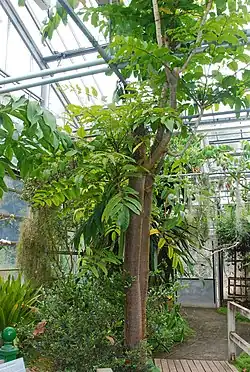Polyscias aemiliguineae
| Polyscias aemiliguineae | |
|---|---|

| |
| Scientific classification | |
| Kingdom: | Plantae |
| Clade: | Tracheophytes |
| Clade: | Angiosperms |
| Clade: | Eudicots |
| Clade: | Asterids |
| Order: | Apiales |
| Family: | Araliaceae |
| Genus: | Polyscias |
| Species: | P. aemiliguineae
|
| Binomial name | |
| Polyscias aemiliguineae Bernardi
| |
Polyscias aemiliguineae is a species of plant in the family Araliaceae.[2] It is endemic to Réunion.
It is a shrub or tree, evergreen, hermaphroditic, andromonoecious or dioecious, unarmed, often glabrous, some with sharply aromatic herbage . Leaves 1-5-pinnately compound, margins entire to crenate or serrate; stipules sometimes intrapetiolar and adnate to inside of petiole or absent. Inflorescence a terminal panicle of umbels, heads or spikes, sometimes with a terminal umbel of bisexual flowers and 1 to several lateral umbels of male flowers. Pedicel articulate below ovary. Calyx undulate or with 4 or 5(-8 or more) small lobes . Petals 4 or 5(-8 or more), valvate . Stamens as many as petals. Ovary 4 or 5(-8 or more) carpellate ; styles free or rarely connate at base . Fruit a drupe, terete or laterally flattened. Seeds compressed, endosperm smooth .
References
- ^ Strahm, W. (1998). "Polyscias aemiliguineae". IUCN Red List of Threatened Species. 1998: e.T32692A9718319. doi:10.2305/IUCN.UK.1998.RLTS.T32692A9718319.en. Retrieved 16 November 2021.
- ^ "Polyscias aemiliguineae Bernardi". www.worldfloraonline.org. Archived from the original on 2023-02-14. Retrieved 2025-05-13.
